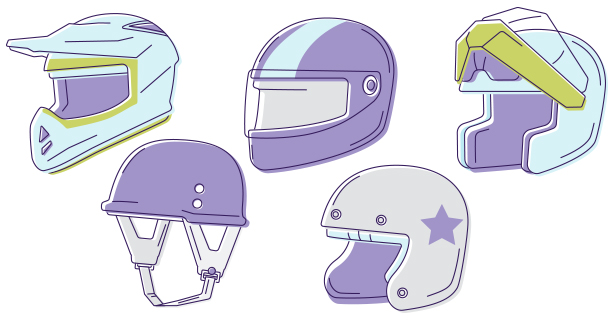What are the types of motorcycle helmets and what is right for you?
0 min. read
While not all states require riders to sport a helmet on the road, we highly recommend making it part of your riding routine to protect yourself. But with all of the different helmets on the market, which one is right for you?
Full-face helmets
Full-face helmets are generally considered the safest option, as they offer the most head and neck coverage, and the integrated chin bar provides an extra layer of protection.
Most modern full-face helmets come with a visor that protects your eyes from bugs and other debris. You can typically raise or remove these visors to clean them or gain some additional air flow. And many high-end full-face helmets come with features like Bluetooth technology and visors that adjust to different levels of sunlight.
Check out more full-face helmet options.
Open-face helmets
Open-face helmets (also known as three-quarter helmets) cover your head while leaving your face exposed to feel the wind as you ride. These helmets are popular with cruiser and scooter owners, and riders who prefer to wear motorcycle goggles or sunglasses.
Many models also have relatively long visors for increased protection from weather and debris. Open-face helmets lack a chin bar, which reduces the overall protective ability of the helmet compared to full-face helmets.
Learn more about open-face helmets.
Modular helmets
Modular helmets, also known as flip-up helmets, have become increasingly popular due to their comfort and versatility. Compared to full-face helmets, the eye openings are more straightforward, and the chin bar sits lower on your face.
Modular helmets essentially combine the structure of open-face helmets and full-face helmets, allowing you to flip up the chin bar and visor to grab some air, a snack, or even communicate face-to-face with another rider while stopped.
Learn why a modular helmet may be right for you.
Half helmets
Half helmets cover the top half of your head, leaving the area below your eyebrows exposed to the elements. Half helmets also don’t typically come with visors or face shields, so while they offer nice airflow, they provide significantly less protection than the other helmets above.
If you choose to ride with a half helmet, be sure to invest in eye protection like sunglasses or goggles so you’re protected from dust, smoke, and debris.
Choose from a range of half helmet options.
Off-road helmets
Off-road helmets are generally designed for riding off-road vehicles, but many riders like them for highway rides as well. While they offer maximum protection with minimum weight—including large visors and accentuated chin bars—they don’t typically include eye protection. So if you choose to wear an off-road helmet, be sure to grab your glasses or goggles before your ride.
Once you’ve decided which one you want, learn how to take care of your helmet so it can take care of you. You’ll also need to know when to replace your helmet, since the key safety materials tend to wear down over time.
Related links
You know how to protect your head while riding. Now discover even more motorcycle safety tips to help keep the rest of you safe out on the road.
Taking a safety course can help you keep safety top-of-mind each time you ride—and it can also help you earn our rider safety course discount.
The general information in this blog is for informational or entertainment purposes only. View our blog disclaimer.
*Data accuracy is subject to this article's publication date.







